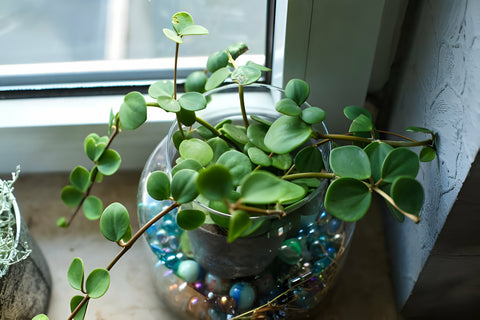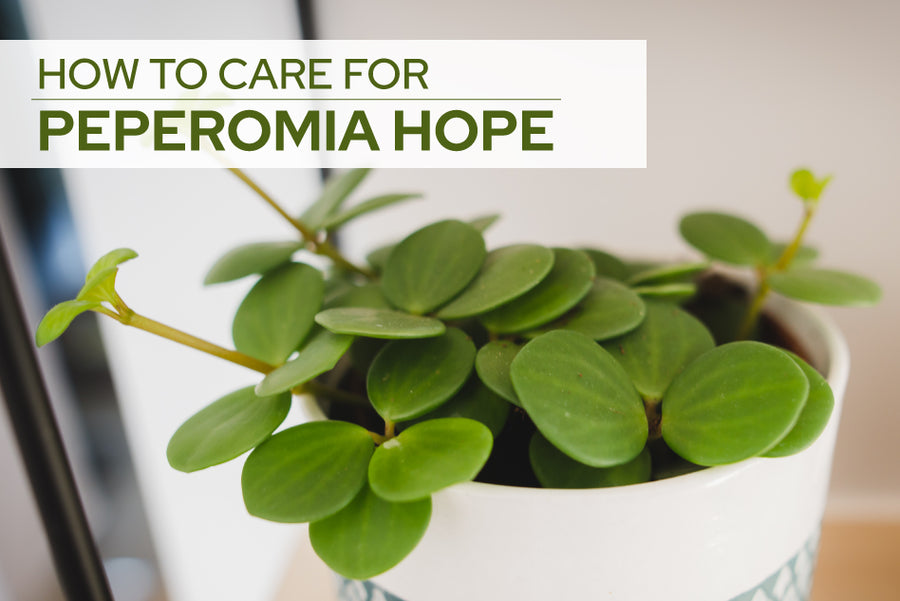Peperomia Hope, a variant of Peperomia quadrifolia, originates from the vibrant regions of Central and South America. Loved by plant enthusiasts for its effortless charm and easy upkeep, this cultivar boasts lush, glossy leaves that cluster along its trailing stems, resembling miniature succulents. With its deep green hue, these leaves add a touch of elegance to any space, whether cascading from a hanging basket or accentuating a plant arrangement. Despite its compact size, Peperomia Hope's cascading growth gracefully spills over edges, making it an ideal choice for cozy nooks, tabletops, or shelves. Its adaptable nature effortlessly enhances the aesthetic of any indoor setting, bringing a vibrant, natural touch to your home decor.
Like other Peperomia varieties, Hope is favored for its adaptability to indoor environments and relatively low maintenance requirements.
Is Peperomia Hope A Succulent?
Peperomia Hope is occasionally grouped with other tropical green houseplants due to its attractive and vibrant appearance. However, Peperomia Hope is actually a succulent. This distinction becomes evident when considering its water storage capabilities and resilience to drought conditions, traits characteristic of succulent plants. While its lush, trailing foliage may resemble traditional houseplants, its succulent nature sets it apart, making it an intriguing and distinctive addition to indoor plant collections.
Unlike many drought-tolerant desert succulents that thrive in poor soil and arid conditions, Hope hails from tropical lands. This means it prefers a slightly different set of conditions, including more consistent moisture and a well-draining, aerated potting mix. While sharing the succulent trait of water storage in its leaves, Peperomia Hope showcases the variety in nature of succulents. They are amazing plants that can adapt to diverse ecological niches, from arid deserts to humid tropical regions. The unique characteristic of Peperomia 'Hope' lies in its ability to blend the appearance of a tropical houseplant with the resilience and adaptability inherent in succulents.
Is Peperomia Hope Toxic?
The Peperomia family, including Hope, are among the best pet-friendly houseplants! They are non-toxic and are safe to keep in homes with furry friends and curious little kids. However, as a precautionary measure, it is advisable to keep plants out of reach of curious pets or small children. While this plant is not toxic, allergic reactions may still happen, as each person or animal has different sensitivities. If there are specific concerns or if anyone in the household has allergies, consulting with a healthcare professional or a veterinarian is recommended.
General Care
Lighting
Peperomia Hope can thrive in most indoor environments. However, the ideal lighting for Hope is bright, indirect, or filtered sunlight, such as near east or west-facing windows. It can also adapt to slightly lower light conditions, but the intensity of its vibrant green foliage may diminish. This adaptability to various lighting situations makes Peperomia 'Hope' a versatile and forgiving plant for indoor settings. Please note that other than the discoloration of the foliage, prolonged periods in very low light conditions also lead to leggy or stunted growth.
While this plant enjoys some direct sunlight, especially in the morning or late afternoon, exposure to intense sunlight can lead to leaf burn or scorching. Therefore, it's advisable to protect it from the harsh midday sun.
If you're introducing Peperomia 'Hope' to a new lighting environment, a gradual acclimation process is beneficial. Start by placing the plant in a location with indirect sunlight and slowly increase its exposure to direct sunlight over a few weeks. This allows the plant to adjust to the light conditions without experiencing stress or damage.

Peperomia Hope needs bright, indirect light to thrive well.
Watering
Peperomia Hope has moderate watering needs, and it's important to strike a balance to prevent both overwatering and underwatering. It prefers to be kept slightly moist but not soggy. The key is to allow the top inch of the soil to dry out before providing more water. Typically, this occurs every 1-2 weeks, but the frequency may vary depending on factors such as temperature, humidity, and the specific conditions of your indoor environment.
Water the soil directly and avoid splashing water on the leaves. This helps prevent fungal issues and keeps the foliage dry. Ensure that the soil is evenly moist but not waterlogged. Peperomias are susceptible to root rot if the soil remains consistently soggy. Discard any water that collects in the saucer beneath the pot to prevent waterlogging.
During the growing season (spring and summer), Peperomia Hope may require more frequent watering. In contrast, reduce the watering frequency in the dormant period (fall and winter) when the plant's growth slows down. Monitoring the soil moisture and adjusting your watering routine accordingly will help maintain optimal conditions for your plant and promote its well-being.
Soil and Fertilizer
Peperomia Hope likes its soil a bit damp but not waterlogged. A good potting mix with peat moss works well because it keeps some moisture while letting excess water drain away. You can find these mixes easily at garden stores. If you want better drainage, mix in some perlite or coarse sand. These help create air spaces in the soil, making it better for the plant. It is recommended that you regularly poke the soil to increase aeration, enhancing drainage and oxygen flow.
For growth, give your Peperomia a balanced, water-soluble fertilizer for houseplants every 4-6 weeks during the growing season. Make sure to dilute the fertilizer, following the instructions on the label. This prevents overfeeding, which can harm the plant. Water the plant well with the diluted fertilizer, making sure it reaches the roots. Don't let the fertilizer touch the leaves, as it might cause them to burn. In the winter, when your Hope slows down in growing, you can take a break from fertilizing. Resume in the spring when the plant starts growing more.

Peperomia Hope is one of the popular pet-friendly houseplants.
Temperature And Humidity
Peperomia Hope, much like other members of the Peperomia family, does well in consistent, moderate temperatures. It thrives when temperatures are kept between 65°F to 80°F during the day and slightly cooler at night. It's essential to shield the plant from temperatures below 50°F, as it can be sensitive to both cold drafts and extreme heat. Keep it away from drafty windows, doors, or heating/cooling vents, as sudden temperature changes can stress the plant. When cultivating this plant outdoors, protective measures should be taken to guard against frost and chilly temperatures.
As a tropical succulent, Peperomia Hope needs moderate to high humidity levels. While it can adapt to average indoor humidity, it thrives in the ideal range of around 40% to 60%. A bit of humidity will boost the growth rate and ensure your plant’s overall health. Methods to increase humidity for Peperomia Hope include misting with water, using a humidity tray with water and pebbles, investing in a humidifier, or grouping plants together to create a microclimate with elevated humidity. It is very important to ensure that your room has good airflow because a humid, stagnant room is the breeding ground for pests and mold.
Extra Care
Potting and Repotting
When it comes to potting, choosing the right pot size with at least one drainage hole is of utmost importance. Select a pot that allows for some room for the roots to grow but not excessively large, as Peperomia Hope has a shallow root system and prefers to be slightly root-bound. Proper drainage is essential to avoid waterlogged soil, which can result in root rot. Opt for a pot made from porous materials such as cement, ceramic, or terracotta, as they help maintain a healthy balance of moisture in the soil.
Repot when you notice the plant becoming root-bound, typically every 1-2 years. If you observe roots growing out of the drainage holes, the plant showing signs of stress, or the soil compacting, it's time to repot. To repot, gently remove the plant from its current pot, shake off excess soil, and inspect the roots. Trim any dead or rotting roots. Place the plant in a slightly larger pot with fresh, well-draining soil. Water the plant lightly after repotting and allow it some time to acclimate to its new environment. Remember to handle the roots delicately during both potting and repotting to avoid damage. Additionally, observe the plant for a few days after any transplant to ensure it adjusts well to its new home.
Pruning
Pruning and shaping Peperomia Hope is a simple yet effective practice to enhance its appearance and encourage healthy growth. Remove any dead or yellowing leaves by making clean cuts at the base of the stem using sharp scissors or pruning shears. This not only improves the plant's aesthetics but also redirects energy to promote new, vibrant growth. If your Peperomia Hope begins to develop leggy or elongated stems, consider trimming them to stimulate a bushier and more compact form. Regular pruning and shaping help maintain the plant's overall structure and ensure a lush and well-maintained appearance. Don’t forget to use only clean tools to prevent the spread of diseases or pests between plants, ensuring the overall health of your green companion. You should also make sharp cuts to promote faster healing for the plant, reducing the risk of infections.

Pruning is the effective way to enhance Peperomia Hope's appearance.
Propagation
Propagating Peperomia Hope is easy through stem cuttings. Begin by selecting a healthy and mature plant, then use clean and sharp scissors or pruning shears to cut a stem measuring around 4-6 inches with several leaves. After trimming off the lower leaves, allow the cut end to callus for a day or two to prevent potential rot. Plant the callused cutting in a well-draining potting mix, designed for succulents or enriched with perlite for improved drainage. Lightly water the soil and place the cutting in a location with indirect sunlight to encourage root development. Ensure the soil dries out between waterings to prevent root rot. After a few weeks, roots should be established, and you can transplant the new Peperomia Hope into a larger container if necessary. Alternatively, you can propagate your Peperomia in water, following the same steps, replacing the potting mix with clean distilled water, and changing the water once or twice a week.
Peperomias can also be propagated with leaf cuttings, but the successful rate is generally lower compared to stem cuttings.
































































































